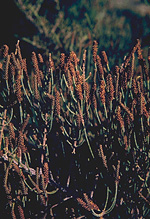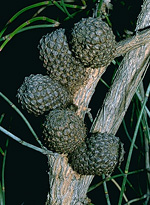 |
Various species of Casuarina and Allocasuarina are important components of shrublands and forests in much of Australia, except the north-central and north-west, particularly on poorer soils. The Family is most diverse in Australia, only a few species occurring elsewhere in the Pacific and South-East Asia.
Characteristic features of the family Casuarinaceae in Australia include: - trees or shrubs with leaves on adult plants reduced to whorls of small, triangular scales on the jointed, finely ribbed green or grey-green branchlets (cladodes)
- flowers unisexual, on the same or separate plants;
- male flowers in whorls near the branchlet tips, with 1-2 small perianth segments and a single stamen
- female flowers in heads, lacking a perianth but with long, feathery, red styles
- cone-like 'fruit' (actually a woody infructescence) with individual cells opening to release winged 'seeds' (actually the true fruit)
Description
Evergreen trees or shrubs. Leaves ±absent. Vegetative reproduction by root suckers. Internal secretions not obvious. Plants ?glabrous or with simple, non-glandular, ?unicellular hairs. Leaves reduced to scales, in whorls of 4–20, sessile. Stipules absent. Lamina simple, symmetric, mostly deltoid; one-veined, with the midrib conspicuous or inconspicuous, herbaceous or leathery. Male and female flowers occurring on the same plant or on separate plants. Inflorescences terminal or axillary, consisting of female capitula and male 'catkins'. Bracts and bracteoles present. Pollination by wind. Flowers odourless; sessile. Floral disc absent; nectaries absent. Perianth regular or irregular, of 1 whorl only with 1–2, free, ±sepaloid segments, or absent, grey, brown or black, without contrasting markings; inner perianth parts herbaceous or papery. Fertile stamen 1, free of the perianth segments, free of the ovary and style. Anthers basifixed, not versatile, opening sideways by longitudinal slits; 2-celled; with basal appendages. Ovary superior and sessile. Carpels 2, fused; ovary with 1 locule. Style terminal, single and branched above or apparently from the base. Ovules 2 (–4), ?sessile; placentation axile or apparently basal. Fruit apparently derived from several flowers and cone-like, dry, dehiscent (trymoconium), true fruit an indehiscent, seed-like samara; the perianth on the maturing fruit deciduous. Disseminule macro-surface (true fruit) winged, rarely with straight hairs; micro-surface ±smooth or finely striate or sulcate, cream, brown, grey or black, glossy or not. Seeds 1–numerous per cone. Aril absent. Cotyledons 2. Embryo straight.
(Note: this description has been generated from the coded data compiled for the key. Any errors in the key data will be reflected in the descriptions.)
A treatment of the family Casuarinaceae has been published in:
Flora of Australia 3: 100-174.
Australian genera of Casuarinaceae (as recognised for the Flora of Australia)
Allocasuarina
Casuarina
Gymnostoma

|
  |

Allocasuarina emuina (female flowers)
Photo: J.McAuliffe © ANBG

Allocasuarina grampiana (habit)
Photo: A.Lyne © ANBG

Allocasuarina humilis (male flowers)
Photo: A.S.George © A.S.George

Allocasuarina scleroclada (fruits)
Photo: D.Greig © ANBG

|
 |
|